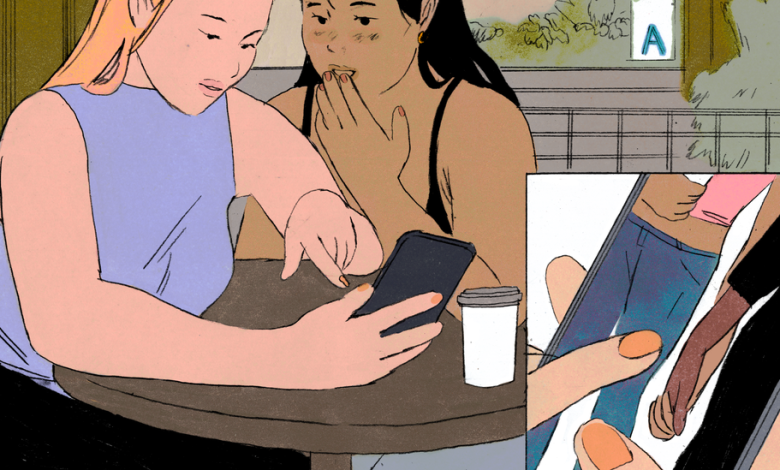A Celebrity Lesbian Romance Changed My Life. (Even if It Never Happened.)

At the bottom of the frame, our narrator’s jaw is on the floor. She’s giggling, spilling someone else’s supposed secrets into the internet’s open mouth. She has a hunch about the women filling the rest of the screen. Tipsy on wild speculation, she’s telling us her theory. A slide show plays, and we watch a montage of two tall blondes holding hands in various locations: a basketball game, an awards show, a night out. Keep scrolling, and another TikTok creator is telling several hundred thousand viewers (and counting) her obsessively researched hypothesis, and we’re liking and reposting, screaming and squealing, frantically texting friends. We’re commenting with wide-eyed emojis as we scroll through video after video of similar scenes, fingers swiping fast, sweating sticky hope onto the phones in our palms.
On TikTok, Tumblr, Twitter and Reddit, posts of this sort rack up multitudes of views, reposts and replies. These posts are often hashtagged #Kaylor, the fan-created couple name for Taylor Swift and Karlie Kloss, famous women who fostered a very public best friendship in the 2010s, one a subset of Swifties believe was actually a tragic, torrid romance conducted both in the closet and on Instagram. (Spoiler alert: These theories are clearly fanciful. In 2014, Swift disavowed media speculation on her love life, tweeting, “As my 25th birthday present from the media, I’d like for you to stop accusing all my friends of dating me.”) Kaylor devotees are close readers, code breakers and conspiracy theorists, finding secret messages in lyrics and hints in online posts, digging up long-lost interview footage for revealing pronoun usage and flashes of flirtation. You can get lost in this world. There are podcasts and in-person meet-ups; there’s merch.
Kaylor isn’t the only “celesbian” fantasy couple. A portmanteau for “celebrity lesbian,” “celesbian” emerged as Sapphic slang at least as early as the late 1990s, but became ubiquitous across the queer cyberverse in the 2010s as gay women made maps of celesbian relationships both rumored and real. Today social media is rife with fervid fans who believe their favorite singer or actress is secretly queer and dating another (sometimes gay and out, sometimes straight and imagined closeted) celebrity who just happens to be her best friend. The musicians Kelsea Ballerini and Fletcher recently took over TikTok, jumping into each other’s arms and serenading each other to a chorus of emoji comments: rainbows and nails and side eyes. This activity does not only center living women, either. TikToks about Marilyn Monroe and Greta Garbo’s same-sex desire abound, webs of whispers and faded photographs spun by women browsing the web. This practice resembles writing fan fiction, but these speculative story lines star your current faves instead of fictional characters.
Kaylor and other rumored celesbian couples are fairy tales for gay women raised on straight ones; fables where two people who appear to be patriarchy’s pinups are actually manipulating the men with money, choosing the girl over all the guys. The fan communities that have formed around these pairs are forged through wondering and wishing, in-jokes and lingo and those in the know. Our touchstone isn’t the friendship itself; it’s a feeling, an act of quiet yearning, a longing look and a passed note. These love stories offer us an opportunity to write our own folklore. When queer women post TikToks and Tumblr manifestoes, they’re writing toward and through their fave — not the pop star, or the actress, or the athlete, but the fantasy of a closeted queer woman agonizingly in love with her best friend, the idol so many women like me desperately want her to be. Personally, I’ve fallen for a best friend before, and am all too familiar with the startle in my throat and the spark in my heart that means this is going to hurt. If I’ve learned anything in this corner of the internet, I’m not the only one. For many queer women, first love means falling for a friend, hiding your feelings and hoping they’ll pass, pretending to like boys — and underneath all that, praying she feels it, too.
This is an experience riddled with shame — the fermenting terror of anyone finding out what you’re thinking, the certainty that you’re a creep in a world that teaches young queer people their desire is wrong, an overstep, a misfired signal. In another world — the alternate universe we find online — wouldn’t it be nice if we were the ones reading the room right for once, and all the straight people were misreading the lyrics and missing the obvious? These theories are wish fulfillment and a choral narrative to scream-sing — a daydream in which Miss Americana, maybe, tells us she knows what we mean and she’s happy we have one another.
Much has been written about the perverse parasociality of fandom, the blurring line between public displays of devotion and invasions of privacy. Queer fandoms often foster an especially ardent passion, passed among people who’ve felt misunderstood and judged for whom they love, finally publicly expressing adoration. The object of their affection isn’t real, per se; they’re a character, a figment of our shared imagination: a collaged angel, or a shattered mirror showing us shards of one another. While the fervent side of fandom is often mocked, this is its underdiscussed, softer side: the tender, bruised and consistently caring communities built on social media by people who’ve felt ashamed of themselves in the same ways. Neither our desperation nor our desires are shameful; actually, our desperation, distilled, might be a love potion or a strong cocktail after a bad day, drunk in a dark bar with the girls you’ve been looking for your whole life.
Emmeline Clein is a writer living in Brooklyn. Her first book, “Dead Weight,” is forthcoming from Knopf in 2024.




